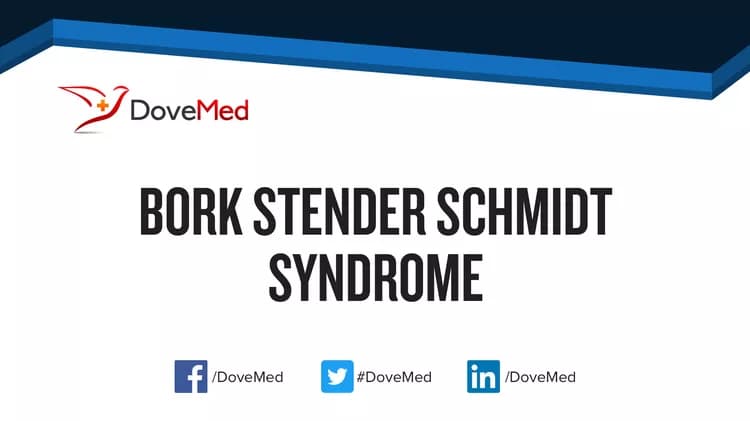What are the other Names for this Condition? (Also known as/Synonyms)
- Bork Syndrome
- Tricho-retino-dento-digital syndrome
- Uncombable Hair, Retinal Pigmentary Dystrophy, Dental Anomalies, and Brachydactyly
What is Bork Stender Schmidt Syndrome? (Definition/Background Information)
- Bork-Stender-Schmidt Syndrome, or tricho-retino-dento-digital syndrome, is an autosomal dominant ectodermal dysplasia syndrome, characterized by uncombable hair syndrome, congenital hypotrichosis and dental abnormalities such as oligodontia or hyperdontia, and associated with early-onset cataract, retinal pigmentary dystrophy, and brachydactyly with brachymetacarpia
- Furthermore, hyperactivity and a mild intellectual deficit have been reported in affected patients
(Source: Tricho-retino-dento-digital syndrome; Orphanet, National Institute of Health and Medical Research (INSERM), Paris.)
Who gets Bork Stender Schmidt Syndrome? (Age and Sex Distribution)
- Bork Stender Schmidt Syndrome is a rare congenital disorder. The presentation of symptoms may occur at birth
- Both males and females may be affected
- Worldwide, individuals of all racial and ethnic groups may be affected
What are the Risk Factors for Bork Stender Schmidt Syndrome? (Predisposing Factors)
- A positive family history may be an important risk factor, since Bork Stender Schmidt Syndrome can be inherited
- Currently, no other risk factors have been clearly identified for this syndrome
It is important to note that having a risk factor does not mean that one will get the condition. A risk factor increases one’s chances of getting a condition compared to an individual without the risk factors. Some risk factors are more important than others.
Also, not having a risk factor does not mean that an individual will not get the condition. It is always important to discuss the effect of risk factors with your healthcare provider.
What are the Causes of Bork Stender Schmidt Syndrome? (Etiology)
- The exact cause of development of Bork Stender Schmidt Syndrome is presently unknown
- It is believed to be a genetic disorder that is inherited in an autosomal dominant manner
Autosomal dominant: Autosomal dominant conditions are traits or disorders that are present when only one copy of the mutation is inherited on a non-sex chromosome. In these types of conditions, the individual has one normal copy and one mutant copy of the gene. The abnormal gene dominates, masking the effects of the correctly function gene. If an individual has an autosomal dominant condition, the chance of passing the abnormal gene on to their offspring is 50%. Children, who do not inherit the abnormal gene, will not develop the condition or pass it on to their offspring.
What are the Signs and Symptoms of Bork Stender Schmidt Syndrome?
The signs and symptoms of Bork Stender Schmidt Syndrome may include:
- Hypospadias
- Microdontia
- Pili canaliculi
- Rod-cone dystrophy
- Short metacarpal
- Short proximal phalanx of finger
- Short toe
Based on the frequency of symptoms observed, the following information may be noted:
Very frequently present symptoms in 80-99% of the cases:
- Abnormality of retinal pigmentation
- Brachydactyly
- Hypotrichosis
- Juvenile cataract
- Uncombable hair
Frequently present symptoms in 30-79% of the cases:
- Increased number of teeth
- Oligodontia
Occasionally present symptoms in 5-29% of the cases: Short 5th metacarpal
(Source: Bork Stender Schmidt Syndrome; Genetic and Rare Diseases Information Center (GARD) of National Center for Advancing Translational Sciences (NCATS), USA.)
How is Bork Stender Schmidt Syndrome Diagnosed?
Bork Stender Schmidt Syndrome is diagnosed on the basis of the following information:
- Complete physical examination
- Thorough medical history evaluation
- Assessment of signs and symptoms
- Laboratory tests
- Imaging studies
- Biopsy studies, if necessary
Many clinical conditions may have similar signs and symptoms. Your healthcare provider may perform additional tests to rule out other clinical conditions to arrive at a definitive diagnosis.
What are the possible Complications of Bork Stender Schmidt Syndrome?
The complications of Bork Stender Schmidt Syndrome may include:
- Dental abnormalities
- Emotional stress due to cosmetic concerns
Complications may occur with or without treatment, and in some cases, due to treatment also.
How is Bork Stender Schmidt Syndrome Treated?
There is no cure for Bork Stender Schmidt Syndrome, since it is a genetic condition. The treatment is usually given to manage the signs and symptoms and any complications that develops.
How can Bork Stender Schmidt Syndrome be Prevented?
Currently, Bork Stender Schmidt Syndrome may not be preventable, since it is a genetic disorder.
- Genetic testing of the expecting parents (and related family members) and prenatal diagnosis (molecular testing of the fetus during pregnancy) may help in understanding the risks better during pregnancy
- If there is a family history of the condition, then genetic counseling will help assess risks, before planning for a child
- Active research is currently being performed to explore the possibilities for treatment and prevention of inherited and acquired genetic disorders
Regular medical screening at periodic intervals with tests and physical examinations are recommended.
What is the Prognosis of Bork Stender Schmidt Syndrome? (Outcomes/Resolutions)
- The prognosis of Bork Stender Schmidt Syndrome is dependent upon the severity of the signs and symptoms and associated complications, if any
- Individuals with mild conditions have better prognosis than those with severe symptoms and complications
- Typically, the prognosis may be assessed on a case-by-case basis
Additional and Relevant Useful Information for Bork Stender Schmidt Syndrome:
The following DoveMed website link is a useful resource for additional information:
Related Articles
Test Your Knowledge
Asked by users
Related Centers
Related Specialties
Related Physicians
Related Procedures
Related Resources
Join DoveHubs
and connect with fellow professionals


0 Comments
Please log in to post a comment.